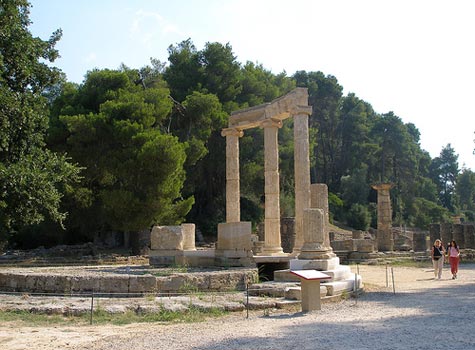The stadium of Olympia, situated east of the sacred Altis enclosure, was where the ancient Olympic Games and the Heraia, the women's games in honour of Hera, were held.
Before the sixth century BC the running events were held on a flat area along the treasuries' terrace, east of the great altar of Zeus.
A first stadium (Stadium I) was formed in the Archaic period (mid sixth century BC) by leveling the area south of the Kronios hill inside the Altis. The west short side of the stadium faced the altar of Zeus, to whom the Games were dedicated. In the late sixth century BC a new stadium (Stadium II) was created east of its predecessor, with a racetrack extending beyond the treasuries' terrace; an artificial bank, three metres high, was formed along the south side, while the hill side formed a natural seating area along the north. The stadium received its final form (Stadium III) in the fifth century when the great temple of Zeus was built. By then the Games had become very popular, attracting a great number of both visitors and athletes, so a new stadium was deemed necessary.
The new stadium was moved eighty-two metres to the east and seven metres to the north, and was surrounded by artificial banks for the spectators. After the construction of the Echo Hall in the mid-fourth century BC the stadium was isolated from the Altis, which shows that the Games had lost their purely religious character and had become more of an athletic and social event.
The racetrack is 212.54 metres long and 30-34 metres wide. Two stone markers 192.27 metres apart - that is one Olympic stade or six hundred Olympic feet (1 foot=32.04 metres), indicate the starting and finishing lines. On the south bank is a podium for judges, and opposite this, on the north bank, the altar of Demeter Chamyne, whose priestess was the only woman allowed to watch the games. The stadium could accommodate approximately forty-five thousand people, but the banks never had permanent seats. There were a few stone seats for the officials, and wooden benches may have been added in Roman times when the stadium was repaired (Stadium IV-V). A stone drain round the track opened at intervals into small basins where rain water collected. A vaulted entrance for the athletes, thirty-two metres long, the so-called Krypte, was built in the late third century BC and a monumental portico was added to its west extremity in the Roman period. A large number of votive offerings, mostly of bronze, were found inside the wells along the embankments. Originally there to supply the spectators with drinking water, these wells, which date to the Archaic period, were subsequently used as votive pits.
The early German excavations first investigated the race track, but the recent German excavations of 1952-1966 uncovered the entire monument. In 2004, the ancient stadium of Olympia will re-live its former glory, since it will host the shot put event of the Athens Olympic Games.



